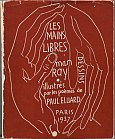Here is a piece of advice to all the collectors out there – next time you come across an opportunity, grab it. I am, of course, referring to the opportunity to make a purchase of a desirable rare book if and when that unexpected chance arrives.
Last November at the Fine Books & Manuscripts Skinner auction, a pair of books featuring Man Ray received some interest from buyers. The Alphabet for Adults, Beverly Hills: Copley Galleries, 1984; first edition one from 500 released, which was also inscribed by Man Ray to his sister with some minor flaws, got sold for $900. The other Les Mains Libres. Dessins illustres par les poems de Paul Eluard, Paris: Editions Jean Bucher, 1937; first edition limited to 675 copies, signed by Man Ray and having some tears and abrasion to the covers, sold for $1440. A few blocks away from the Skinner auction site, a copy of this same book was offered for sale by a dealer at the Boston International Antiquarian Book Fair, during the same weekend for $1200. The dealer was ready to accept $950 after pointing out that the book had undergone some professional restoration even though one could hardly tell. Of course I did not purchase the book and I was not the high bidder on any of the auctioned lots.
On-line sellers are currently asking much more for these books and the majority of the time books sell at auctions for lower amounts than what we see posted on various on-line marketplaces. These two are some of the most desirable books of Man Ray available today along with Photographs 1920–1934: New York: James Thrall Soby & Random House, 1934 and Facile, Paris: GLM, 1935, first edition limited to 1225 copies. A 2004 edition of Facile was reprinted by Bibliotheque Des Introuvables and it is close to being sold out.
Primarily remembered for his photographic work developed without the use of a camera, the American-born pioneer of Surrealism and Dadaism, found his home among the Parisian avant-garde in the early 1920s. He was also famous for his paintings and sculptures but his main focus was his photographs that contained abstract imagery of objects captured on photographic paper exposed to selections of light sources.
Beginning with last year, Man Ray’s photography attracted new interest from collectors who bought his works at record prices. The Man Ray Trust which is holding the majority of his collectibles has been slowly moving towards selling all of its holdings to institutions, such as the Centre Pompidou and the New York Museum of Modern Art. This shift of ownership has a significant effect on supply and price since institutions are permanent holders. Rayograph With Hand, Lens, and Egg, an abstract photograph from 1922 got sold for $866,500 in December at Sotheby’s, more than double its originally estimated value. The same auction house sold in Paris last May the Two Pased Image for 3.2 million USD, the highest price to be paid for any Man Ray work ever. A similar picture from 1921, of a portrait of his friend, Mr. Duchamp, covered in shaving suds will be auctioned this coming April at Christie’s in New York.
What does the surge in interest mean to the rare book collector? While the supply of Man Ray books may not be shifting along with his photographs, portraits, painting or sculptures, there is a direct relationship between art and books. Higher prices for the artist’s works should also propagate to the artist’s books, especially the limited editions, signed copies and so forth. Furthermore, any new publicity that the artist receives should impact demand for his books as well. Last week, the National Portrait Gallery in London, opened its exhibit of “Man Ray Portraits,” featuring 150 works created between 1916 and 1968. Also, last January 31, the Museum Ludwig in Cologne opened another Man Ray show featuring rare contact prints. Publicity is what it is all about. Unfortunately for the artist and the missed opportunist it usually arrives when least expected and often missed.


{ 0 comments… add one now }
{ 3 trackbacks }